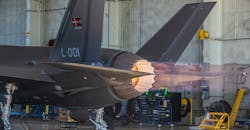Pentagon Clears Pratt & Whitney to Resume F-135 Deliveries
Pratt & Whitney has been cleared by the U.S. Dept. of Defense to resume deliveries of the F-135 engine for the F-35 Lightning II Joint Strike Fighter program, following a halt imposed to determine the cause of a high-profile F-35 crash.
In that December 15, 2022 crash, captured on a widely circulated film clip, a F-35B bounced while attempting a vertical landing in Texas, and then flipped over as the U.S. Marine Corps pilot ejected safely.
The cause of that incident was determined to be “harmonic resonance” developing in a limited number of F-135 engines, causing uncontrollable engine vibration.
The vibration issue was found to be associated with the number of flight-hours accumulated by the engines, and it is considered to be a systemic problem, not one caused by failed or defective parts.
F-135 engine-builder Pratt & Whitney has developed a remedy to address the harmonic resonance problem, and has implemented that change to its manufacturing process.
Additionally, a Pratt spokesperson explained that the same solution can be implemented without extensive time out of service for F-135 engines already in place with F-35 aircraft.
The pause in deliveries of completed F-135 engines reportedly has impacted the production schedule for Lockheed Martin, the F-35 manufacturer, with more than a dozen aircraft left waiting for their powerplants.
The Pentagon’s F-35 Joint Program Office (which coordinates activities among the numerous suppliers) stated that it is working “to ensure incorporation of mitigation measures that will fully address/resolve this rare phenomenon in impacted F135 engines.”
